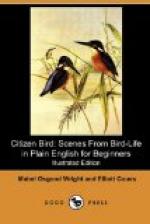Belonging both to the Tree Trappers and Fruit Sowers.
CHAPTER XIV
THE SWALLOWS
“’Rap has been watching the Barn Swallows,” continued the Doctor, after the children had been over to the cedar belt to see if the flock of polite birds were there still. “He thinks there are a great many cousins in the Swallow family, but can’t tell them apart.
“There are ten species of North American Swallows, four of which are very familiar birds in all parts of the United States. These are the Purple Martin; Barn Swallow; Tree Swallow; and Bank Swallow.
“As a family it is easy to name the Swallows from their way of flying. All are officers who rank high in the guild of Sky Sweepers, being constantly in the air seizing their insect food on the wing; thus they kill all sorts of flies, flying ants, small winged beetles, midges, and mosquitoes. They have lithe and shapely bodies, strong, slender wings, wide mouths, and flat, broad bills coming to a sharp point, which makes it easy for them to secure whatever they meet in the air. So swift and sure is their flight that they can feed their newly flown nestlings in mid air; but their feet are small and weak, so that in perching they usually choose something small and easy to grasp, like a telegraph wire.
“Though they nest in all parts of the country, some species going to the Fur Countries, as far north as any trees grow, yet they all seek a very warm climate for their winter home, because it is only in such places that the insects of the air are found. The distance, therefore, between the summer and winter homes of the Swallow family is very great, and these brave little birds are wonderful travellers.
“They are so swift on the wing that they do not fear to fly in the day-time, and so escape a great many of the accidents that overtake birds who travel by night. They come to the middle parts of the United States during the month of April, and start on their southward journey during late September and early October.
“After mating they either choose separate nesting places, or keep together in colonies. In early autumn they gather in great flocks along the borders of rivers, ponds, and lakes, often also on sea beaches, where they fly to and fro, as if strengthening their wings for the long flight they intend to take. It has been recently discovered by the Wise Men that these birds, who had been supposed to eat nothing but insects, feed at this time upon the same bayberries of which the Yellow-rumped Warbler is so fond; and that is one reason why they stay by the sandy wastes where these bushes grow. But no doubt Rap could have told us that, if we had asked him about it. Another reason for lingering near water is, that winged insects fly about wet places later in the season than they do in dry ones.”




